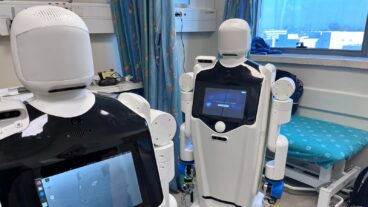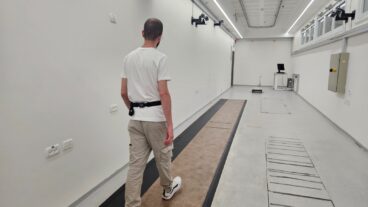Firesys’s main selling point is its unparalleled quick response time, generally associated with more expensive technologies.Detecting smoke and fire quickly and effectively is important anywhere.
But in certain environments – for example, the engine room of a cruise ship, inside a petrochemical plant, or in a valuable, historic wooden building – every split-second counts. The speed with which a rise in the temperature caused by fire is discovered and addressed can mean the difference between a minor incident and a deadly and expensive tragedy.
Firesys is an extra-sensitive fire detection system technology developed by Israeli mechanical engineer Eli Hatsir, specially designed for installation in places where even the first flicker of a fire can spell disaster.
The six-year-old company has developed innovative heat sensitive cables and detectors, based on a linear detection system with a faster response time than conventional cable and detectors that exist today. The new technology is a unique combination of thermodynamics and electronic circuits – so fine-tuned that its response to a rise in heat is detected within milliseconds.
After a year of testing, investigation, and comparing them to their competitors, the Israel Defense Force was impressed with the FireSys system and recently contracted with the company to begin having the system installed in their tanks.
Hatsir is determined, however, to move beyond military use, and wants to introduce the Firesys system to the private sector, targeting markets such as the petro-chemical industry, electric companies, the engine rooms of ships and yachts, and historic restored buildings & sites.
His main selling point is his product’s unparalleled quick response time, generally associated with more expensive technologies.
“Detection systems like this already exist – they are not as advanced as ours, but similar – that are being used in military,” he told ISRAEL21c. “But right now, the companies that manufacture the top-of-the-line fire detectors for the military cannot sell their products for commercial use. Bringing the detector to the demanding military specification makes it extremely expensive.”
His challenge is to convince the commercial and residential markets to upgrade their methods of fire detection, which he says are currently inadequate – and he says he can make it affordable.
“Military products are effective but expensive, and the commercial products are cheap and less effective. There was no product that could cross the line for both. Only Firesys is on the way to do this.”
Hatzir immigrated to Israel from Morocco in 1965 at the age of 14. After completing high school and his army service, he studied mechanical engineering at Ben-Gurion University of the Negev. Following his studies, for 16 years, he worked developing firefighting equipment at a large company where he honed his skilled in product development.
When he left the company, he decided to develop his idea to fill an important niche – cutting-edge high-quality linear fire detection at an reasonable price.
“Working in the field as long as I had I had, you know what’s on the market and what does and doesn’t have a solution. I knew that in some industries, the heat and flame detectors based on metal cables being used in harsh environments like an engine room weren’t able to hold up,’ he said.
The Firesys device Hatsir developed is a metal cable or ‘wire’ with the flexibility of plastic that snakes throughout the entire protected area. The wire is connected to a control panel housing the electronics and other devices in one compact unit. The mechanism for detecting fire and/or excessive heat is continuously active and effective along the full length of the wire.
The system operates according to two principally different mechanisms of detection. The first mechanism is based on direct exposure of the wire to a fire, while the second mechanism is based on the ability of the wire to sense heat at a distance from a fire.
The product is based on fundamental principles of thermodynamics, heat transfer, and electro-mechanics. The combination of the electronics, mechanics, and computer oriented fire/excessive heat algorithms results in a unique rate of temperature rise technology detector.
Hatsir says that his product is made out of sturdy metal, but with the flexibility of plastic.
“When you have plastic detectors, they cannot be tested – once it melts, that’s it, you can’t test it once it’s installed. Ours are always working, even if they are exposed to a direct flame. They are appropriate for outdoor use and can survive in temperatures far below zero.
“We’re suited to systems that have a lot of extreme temperatures, in ships and boats, engine rooms, in petrochemical plants.”
After leaving Spectrex, Haztzir went looking for funds to develop his and eventually entered the Israeli government’s Technological Incubators program, entering ATI, the incubator in Ashkelon, near his home in Ashdod.
After ‘graduating’ his company from the program two years ago, he has continued to move forward.
“One we had the pilot prototype, we introduced it to various institutes and universities, and most importantly, to the Israeli army.”
The army, he said, spent a year of testing comparing the Firesys product to the existing military one, and found his product superior. This was when he began contracting with the IDF and adapting their product for two specific applications for tanks and other vehicles. One application is for the engine compartments of weaponry, including one application he is particularly proud of – the first ever to offer protection and recourse against Molotov cocktails.
While further contracts with the IDF will provide his bread and butter, Hatsir continues to seek markets beyond the military and beyond Israel.
While his system is internationally patented, has had trouble marshalling the level of investment needed to seek the required licenses to sell his system in a large number of countries. He has had to focus on specific locations, and thus far, has had response in Scandinavia, where the conditions are good and sales have taken place.
“In Scandinavia, you have open-minded people willing to try new ideas, a wealthy country where they can afford to try something new, and a definite vulnerability to fires because they have so many wooden structures.”
An evaluation at a Norwegian university examining four types of Linear Heat detectors and comparing them in various areas of use, the study found FireSys the best choice, with the shortest detection time, highest sensitivity. If was also found to be most userfriendly and the most economical of the four.
He dreams of a more sweeping international marketing strategy, which will involve adapting to the requirements of various militaries and beginning pilot projects in other European countries and the United States.












